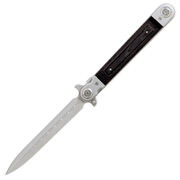mNo edit summary Tag: rte-wysiwyg |
(→Uses) |
||
| (One intermediate revision by the same user not shown) | |||
| Line 8: | Line 8: | ||
==Uses== |
==Uses== |
||
| ⚫ | |||
| + | Similar daggers became infamously used by assassins during the Renaissance. Many Europeans during this time wore long-coats or cloaks, which could easily hide concealable knives: creating the term 'cloak and dagger'. |
||
| ⚫ | The stiletto was primarily for stabbing and thrusting, although it could also be used for cutting and slicing. The locking mechanism, combined with the blade's narrow, pointed blade, made it highly effective when thrusting, unlike most present-day switchblades. |
||
| + | |||
| + | [[Mafia|Gangsters]] would carry these small blades because they were easy to hide in their pockets. Gangsters have carried many other knives; including [[Ice Pick]]s and other kitchen blades. |
||
[[Category:Modern Weapons]] |
[[Category:Modern Weapons]] |
||
[[Category:Knives and Daggers]] |
[[Category:Knives and Daggers]] |
||
Revision as of 01:02, 10 March 2019

The Stiletto
The Stiletto is a small, switchblade knife. It was the Close-Range weapon of the Al Capone gang.
Description
The Stiletto had a folding, automatic opening design, allowing the blade to be unfolded with the push of a button. The blade is relatively long, slender, and straight, tapering to a needle-like point and having a vestigal cross-guard (much like the medieval daggers of the same name). Most of these weapons had a locking device to keep the blade locked in the open position. Knives similar to the modern stiletto have existed in the late middle ages in Europe.
Stats
- 5 inch blade
- 6 oz
- Steel blade
Uses
The stiletto was primarily for stabbing and thrusting, although it could also be used for cutting and slicing. The locking mechanism, combined with the blade's narrow, pointed blade, made it highly effective when thrusting, unlike most present-day switchblades.
Similar daggers became infamously used by assassins during the Renaissance. Many Europeans during this time wore long-coats or cloaks, which could easily hide concealable knives: creating the term 'cloak and dagger'.
Gangsters would carry these small blades because they were easy to hide in their pockets. Gangsters have carried many other knives; including Ice Picks and other kitchen blades.